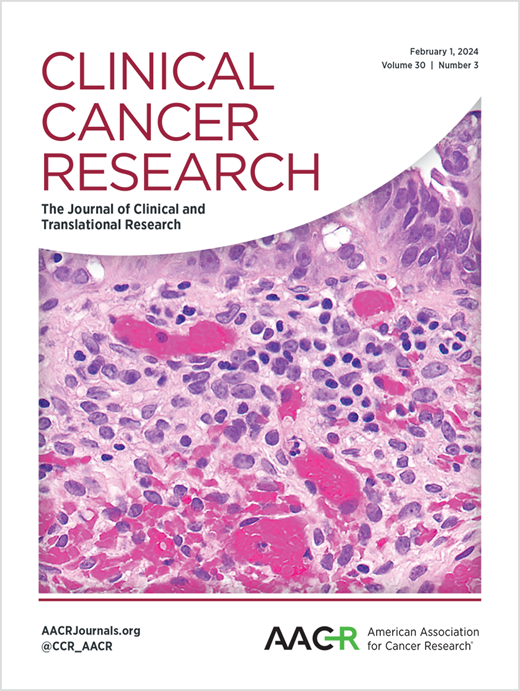子宫内膜癌分子亚型PI3K通路基因突变在单细胞水平上的进化和共发生
IF 10.2
1区 医学
Q1 ONCOLOGY
引用次数: 0
摘要
目的:PI3K通路在&;gt;85%的子宫内膜样子宫内膜癌(EECs),多突变通常同时发生。然而,单药PI3K途径抑制剂的治疗效果有限。我们使用单细胞测序来确定按分子亚型分层的EECs中共同发生的PTEN、PIK3CA和/或PIK3R1体细胞突变是通过趋同进化还是线性进化产生的。方法:选择无特异性分子谱(NSMP, n=5)、错配修复缺陷(MMRd, n=3)和POLE (n=3)亚型同时发生PI3K通路突变的冷冻EECs,针对64个癌症相关基因和PTEN、PIK3R1、PIK3CA编码序列的热点变异进行单核DNA测序。使用EEC细胞系和非恶性样本来确定错误率并过滤假阳性呼叫。结果:单核分析(n=50,009个细胞)显示,在NSMP EECs中,共同发生的PIK3CA, PIK3R1和/或PTEN突变通过线性进化影响几乎所有细胞。MMRd EECs显示出更高水平的遗传异质性,PI3K通路基因突变在细胞亚群中占3.9%-96%。在趋同进化过程中,POLE EECs的克隆多样性最高,并具有多个次要亚克隆结构。我们发现近克隆PI3K通路基因改变(>95%)和多个次要的,相互排斥的亚克隆之间存在明显区别,仅影响1.4%-27%的肿瘤细胞测序。结论:我们的探索性假设分析表明,与NSMP脑脊液相比,MMRd/POLE脑脊液中PI3K通路的改变进化明显,这可能具有治疗效果。在PI3K通路亚克隆改变的EECs中,需要进一步研究信号输出和PI3K通路抑制剂的反应。本文章由计算机程序翻译,如有差异,请以英文原文为准。
Evolution and co-occurrence of PI3K pathway gene mutations in endometrial carcinoma molecular subtypes at the single-cell level
Purpose: The PI3K pathway is altered in >85% of endometrioid endometrial carcinomas (EECs), with multiple mutations commonly co-occurring. Yet, the therapeutic effects of single-agent PI3K pathway inhibitors have been limited. We used single-cell sequencing to determine whether co-occurring PTEN, PIK3CA, and/or PIK3R1 somatic mutations in EECs stratified by molecular subtype originated through convergent or linear evolution. Methods: Banked frozen EECs with co-occurring PI3K pathway mutations of no specific molecular profile (NSMP; n=5), mismatch repair-deficient (MMRd;n=3), and POLE (n=3) subtype were selected for single-nucleus DNA sequencing targeting hotspot variants of 64 cancer-related genes and the PTEN, PIK3R1 and PIK3CA coding sequences. EEC cell lines and non-malignant samples were used to define error rates and filter false-positive calls. Results: Single-nucleus analyses (n=50,009 cells) revealed that in NSMP EECs, the co-occurring PIK3CA, PIK3R1, and/or PTEN mutations affected nearly all cells through linear evolution. MMRd EECs displayed higher levels of genetic heterogeneity, harboring PI3K pathway gene mutations in subsets of cells ranging from 3.9%-96%. POLE EECs had the highest level of clonal diversity and harbored multiple minor subclonal structures in all cases, through convergent evolution. We found a clear distinction between nearly clonal PI3K pathway gene alterations (>95%) and multiple minor, mutually-exclusive subclones only affecting 1.4%-27% of the tumor cells sequenced. Conclusions: Our exploratory, hypothesis-generating analysis suggest that PI3K pathway alterations evolve distinctly in MMRd/POLE compared to NSMP EECs, which may have therapeutic consequences. Further studies on the signaling output and PI3K pathway inhibitor response in EECs with subclonal PI3K pathway alterations are warranted.
求助全文
通过发布文献求助,成功后即可免费获取论文全文。
去求助
来源期刊

Clinical Cancer Research
医学-肿瘤学
CiteScore
20.10
自引率
1.70%
发文量
1207
审稿时长
2.1 months
期刊介绍:
Clinical Cancer Research is a journal focusing on groundbreaking research in cancer, specifically in the areas where the laboratory and the clinic intersect. Our primary interest lies in clinical trials that investigate novel treatments, accompanied by research on pharmacology, molecular alterations, and biomarkers that can predict response or resistance to these treatments. Furthermore, we prioritize laboratory and animal studies that explore new drugs and targeted agents with the potential to advance to clinical trials. We also encourage research on targetable mechanisms of cancer development, progression, and metastasis.
 求助内容:
求助内容: 应助结果提醒方式:
应助结果提醒方式:


